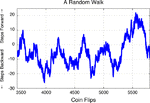DionysusToast
Legendary member
- Messages
- 5,965
- Likes
- 1,501
But not by me, of course.
I would like to discuss support & resistance. I would also like for us all to keep an open mind and I promise to do the same.
The specific thing I would like to discuss about support & resistance is WHY it works when it works. I guess we could also discuss WHY it doesn't work when it fails.
Now - I have seen support & resistance work and fail on the e-mini S&P. When S&R works in the short term, my theory is that it is the target for a lot of the traders that entered below resistance or above support. They may have got in 6 points below resistance and have exit orders at or prior to that point. The selling at resistance is as likely to be longs exiting as much as shorts entering.
As it price hits reistance, the ask usually thickens up and when that is not fake, the logical thing to do for any short term trader is to now attempt a run to the opposite side. When the ask is fake, then the likeliness is that price will move through the resistance by 4 ticks or so at which points the fakers are finished.
In terms of short term support & resistance on the e-mini. 99.999% of participants are aware of the concepts of support & resistance. There is not a significant number of players unaware of the concepts of S&R who suddenly see 'value' at the support point and get back in long again.
As for things that can make S&R fail in the short term on the S&P. As has been discussed, flippers faking strength/weakness can sucker people in to thinking S or R is working & then blow through it. There is also the underlying markets. The S&P is merely a derivative of the underlying market and so excitement in one sector or the overall market may prevent e-mini traders' selling at resistance having much impact. If the stock markets are rising, then program trading will come in and buy the futures if they pullback significantly. So we have both intentional S&R failure based on e-mini traders and unavoidable S&R failure based on a major market move.
This is one case and one timeframe. First of all -feel free to critique my opinion on short term S&P moves. Secondly - feel free to pick a timeframe/market and explain the possible dynamics behind S&R working and/or failing.
DT
I would like to discuss support & resistance. I would also like for us all to keep an open mind and I promise to do the same.
The specific thing I would like to discuss about support & resistance is WHY it works when it works. I guess we could also discuss WHY it doesn't work when it fails.
Now - I have seen support & resistance work and fail on the e-mini S&P. When S&R works in the short term, my theory is that it is the target for a lot of the traders that entered below resistance or above support. They may have got in 6 points below resistance and have exit orders at or prior to that point. The selling at resistance is as likely to be longs exiting as much as shorts entering.
As it price hits reistance, the ask usually thickens up and when that is not fake, the logical thing to do for any short term trader is to now attempt a run to the opposite side. When the ask is fake, then the likeliness is that price will move through the resistance by 4 ticks or so at which points the fakers are finished.
In terms of short term support & resistance on the e-mini. 99.999% of participants are aware of the concepts of support & resistance. There is not a significant number of players unaware of the concepts of S&R who suddenly see 'value' at the support point and get back in long again.
As for things that can make S&R fail in the short term on the S&P. As has been discussed, flippers faking strength/weakness can sucker people in to thinking S or R is working & then blow through it. There is also the underlying markets. The S&P is merely a derivative of the underlying market and so excitement in one sector or the overall market may prevent e-mini traders' selling at resistance having much impact. If the stock markets are rising, then program trading will come in and buy the futures if they pullback significantly. So we have both intentional S&R failure based on e-mini traders and unavoidable S&R failure based on a major market move.
This is one case and one timeframe. First of all -feel free to critique my opinion on short term S&P moves. Secondly - feel free to pick a timeframe/market and explain the possible dynamics behind S&R working and/or failing.
DT

